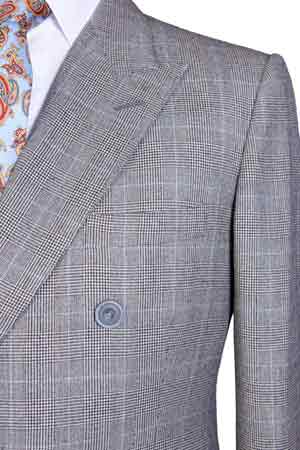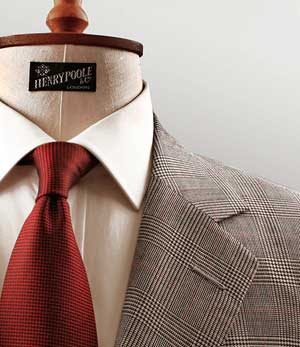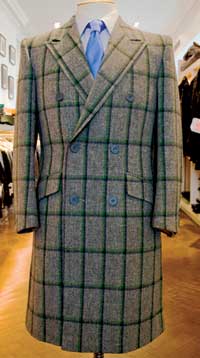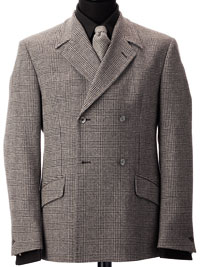|
CHECK OUT THE OPTIONS
Checks for country, stripes for town – that has been the tradition. Around the boardroom, plain or striped suitings dominate the proceedings, with the odd pick ‘n pick or discreet birdseye  chosen by the more avantgarde. Bold checks have been seen as strictly for one’s bookmaker or certainly more for the race course than the AGM. chosen by the more avantgarde. Bold checks have been seen as strictly for one’s bookmaker or certainly more for the race course than the AGM.
But there are checked varieties that are acceptable for the most serious of meetings, and plenty that look smart, sophisticated and business-like for other occasions, depending upon how they are worn.
Some dark checks in fine worsteds are only hardly distinguishable from stripes – but the wearer knows. For the bold are black and white designs, from the shepherd to the outstanding Glenurquhart - an estate check. And the wonderful varieties and colours available in other estate designs, chosen largely for sports jackets, may be coordinated with plain vest and trousers, to give the formality of a suit with rather more colour and more casual styling.
 The ubiquitous Prince of Wales check comes regularly into the spotlight, with support from the Prince of Wales himself. Initially a country choice by Edward Vll, it is now one of the few checks that has City acceptance – in some circles. The ubiquitous Prince of Wales check comes regularly into the spotlight, with support from the Prince of Wales himself. Initially a country choice by Edward Vll, it is now one of the few checks that has City acceptance – in some circles.
Window pane checks, the check muted on a dark ground, will blend in to any cityscape. Some require close inspection to reveal their check nature, but extroverts can indulge in those that offer more colour to liven business proceedings.
At top, not strictly a Prince of Wales check in these grey/blue tones but generally called a Prince of Wales, it comes in a classic Duke of Windsor d.b. style with peaked lapels from the tailor who made for the Duke of Windsor, Davies & Son.
Above, a true Prince of Wales in the brown/red tones that then Prince of Wales/Edward Vll specified in the mid-1800s. It comes in a s.b. style with notched lapel from Henry Poole.
The black and white family provides rich pickings. It has formal acceptance, as in dog tooth or shepherd checks being acceptable for trousers with morning coats; and Prince of Wales connections in its Glenurquhart guise, often wrongly described as Prince of Wales. In between these small and large versions are a wealth of patterns in black and white that deserve wider application. It has formal acceptance, as in dog tooth or shepherd checks being acceptable for trousers with morning coats; and Prince of Wales connections in its Glenurquhart guise, often wrongly described as Prince of Wales. In between these small and large versions are a wealth of patterns in black and white that deserve wider application.
And not to be overlooked is the way that a checked pattern will show off a tailor’s talent, as seen in the wonderful matching of designs in these illustrations.
Estate checks provide hours of innocent pleasure in their study. All of the great estates had their own patterns, and how they were created and for what purposes is a fascinating history of British cloth. For the dedicated cloth afficionado, the book "Scottish Estate Tweeds" by Ned Harrison is well worth finding.
But these checks are very much  seen as tweed patterns - though they do also feature in other cloths - and are usually for sports jackets. But as with the black and white check jacket here, team a tweed jacket with coordinating plain trousers and vest, and it becomes more formal. seen as tweed patterns - though they do also feature in other cloths - and are usually for sports jackets. But as with the black and white check jacket here, team a tweed jacket with coordinating plain trousers and vest, and it becomes more formal.
In the formal worsted sector, as an alternative to checks and stripes, such patterns as pick and pick, pinhead, herringbone, birdseye, barleycorn and corkscrew provide small neat designs that in muted tones are every bit as sober but rather more interesting than the perennial pinstripe. Any tailor will be able to show examples of these in their bunches.
For those who remain wedded to sober stripes for suits, a statement check coat like this one presents a bolder face to the outside world. In a tweed exclusive to Richard Anderson, it clearly shows off check matching expertise. And in a classic black and white check, the d.b. jacket above may be teamed with black shirt (as here) and trousers or even a black polo to look stylishly businesslike. From Mark Powell (see also Style p2).
|